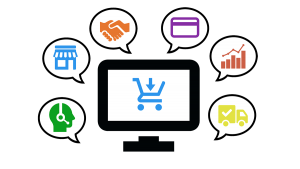Newbies: Welcome To the World of eCommerce
New to the world of eCommerce?
Whether you already have an eCommerce store, or are considering implementing one, it’s important to know the basics for a market projected at $12 trillion by 2020.
eCommerce Defined:
eCommerce, also known as electronic commerce, is the buying and selling of goods electronically on the internet.
In 1984, the world’s first online shopping system was launched by Tesco. Since the internet was still young then it was not launched through a computer. Jane Snowball, who is considered the first “online shopper”, ordered her groceries via her television. Tesco turned televisions into computer terminals in an effort to help the elderly. This was the basis for the launch of the online shopping phenomenon.
Since then, eCommerce has continued to improve and grow over time with a projected market value of $12 trillion by 2020. That’s an incredible market value. With so many companies already in the thick of eCommerce, how can your business profit too?
First, know your market:
Under which category does your business fall?
Business to Business (B2B)
The electronic transactions of goods and services conducted between businesses
Example: Intel, sells software to other companies.
Business to Consumer (B2C)
The establishment of electronic business relationships between businesses and consumers.
Example: Macy’s.com is an online store that sells numerous goods.
Consumer to Consumer (C2C)
All electronic transactions of goods or services are conducted between customers.
Example: On EBay.com, the seller auctions off a computer.
Consumer to Business (C2B)
An individual makes their services and/or products available for purchase to companies in search of these services and/or products.
Example: A freelance writer offering their services to a company’s blog.
Business to Administration (B2A)
Transactions conducted online between companies and public administration.
Example: Local government purchases an online security system.
Consumer to Administration (C2A)
Electronic transactions are conducted between individuals and public administration.
Example: A patient paying for a doctor’s office visit.
It’s possible that your company falls under several of these categories at once. If you sell a product wholesale to other businesses, and retail to customers, you could be both B2B and B2C.
eCommerce utilizes a variety of applications, including:
- online catalogs
- shopping carts
- web services
These applications are directed to, and for, the consumer. The positive consumer experience is what companies thrive on. This is what increases loyalty and repeat buyers. Consequently, businesses need to make their consumers to feel important. This can be done by:
- sending special offers
- emailing coupons
- providing information about upcoming sales via email
- ads via social media websites & search engines
- targeted ads based on previous purchases
Ever notice product placement on your social media sites for stores you have visited? That’s a form of eCommerce advertising, call retargeting.
Government Regulations for eCommerce:
All forms of advertising have rules and regulations they must uphold, including electronic marketing. All claims sent through any form of advertising must be truthful. Additionally, businesses running eCommerce are legally required to include an “unsubscribe option”. If a customer chooses to unsubscribe, the company must honor the request. The Federal Trade Commission is a great source for spam compliance. Similarly, any company with a corporate website that displays their products and services, must provide a safe and secure electronic transactions system, offer order tracking, and lists products’ technical details.
Advantages of eCommerce:
One of the main advantages of eCommerce is the fact that it is available 24/7. Consumers can log into their social media accounts, email account(s), and favorite online stores from virtually anywhere at any time! Consumers have numerous options when searching for a product because the “Worldwide Web” is literally worldwide. This saves the consumer a lot of time and frustration because they do not have to drive to the nearest mall in order to purchase their items. In addition, many consumers feel hounded when they enter a store and enjoy not having to speak to a salesperson online. A happy customer is a return customer!
Disadvantages of eCommerce:
On the other hand, although there are many advantages to eCommerce, there are a few disadvantages:
- Consumers cannot touch or test the products they are interested in purchasing as they can in-store.
- Perceived loss of user privacy.
- Older generations aversions to online shopping/
Typically, online stores will remember the consumers’ previous orders and send them special promotions and/or coupons on future purchases. This is known as retargeting. While excellent for marketing purposes, arguably, some consumers prefer not to give out their email addresses.
Lastly, eCommerce is dependent on information and communication technologies. Some consumers do not participate in “online shopping” due to the fact that they prefer to view and purchase products in person. However, with today’s technology and the maturity of the millennial age group, this practice is slowly dwindling.
A great eCommerce strategy can alleviate some of these concerns. For this reason, it is very important to ensure your platform is optimized to your audience.
What Works for Your Business?
All things considered, when properly implemented, eCommerce is invaluably beneficial to businesses. Does your business understand what your consumers want and need? Armed with that information you can connect and optimize an eCommerce management system to implement automated processes, and increase transactional sales.
Online business is commonplace today. eCommerce boots your business’ exposure, as well as sales. Correct optimization also increases customer satisfaction. Because of the positive benefits of eCommerce, many feel the pull to become part of the online shopping phenomenon. With good reason, this market has grown exponentially and will continue to expand for years to come.
author bio
Sonja Fridell
Sonja is very active in architecting CRM, ERP and marketing automation solutions for clients across North America. As an ex-journalist, she is adept at exploring a client’s needs and coming up with cutting edge, elegant solutions that fit, drive adoption, and create real results.
view all articles
Stay in the Loop
Subscribe to get all our latest content sent directly to your inbox!





